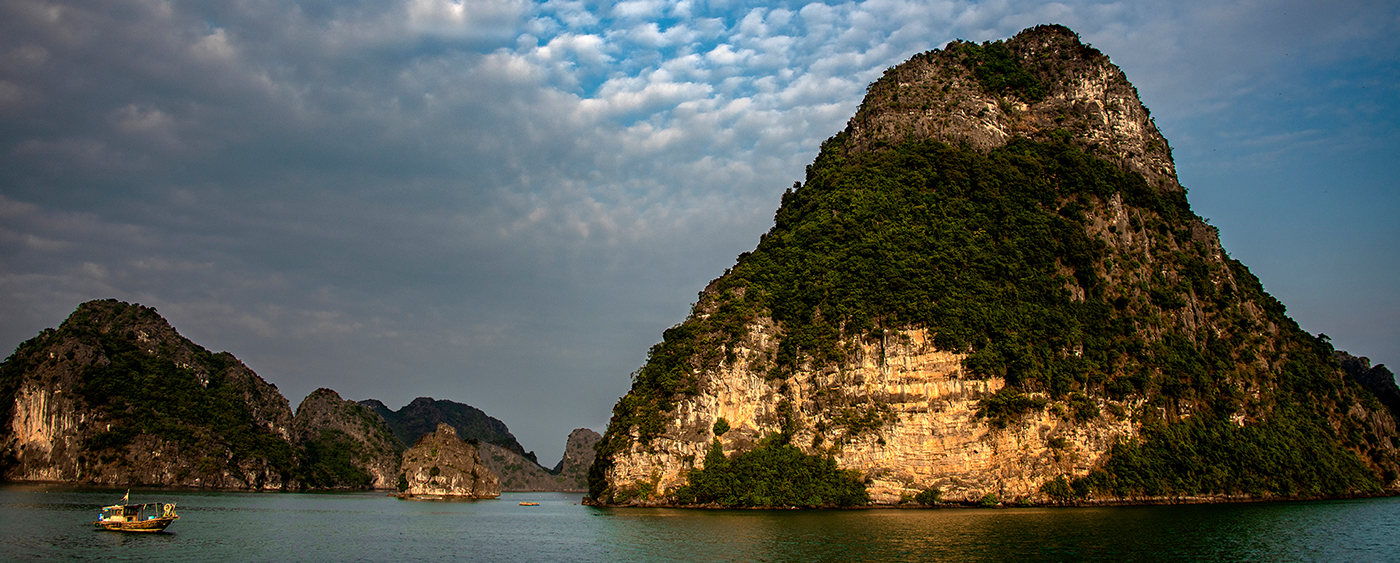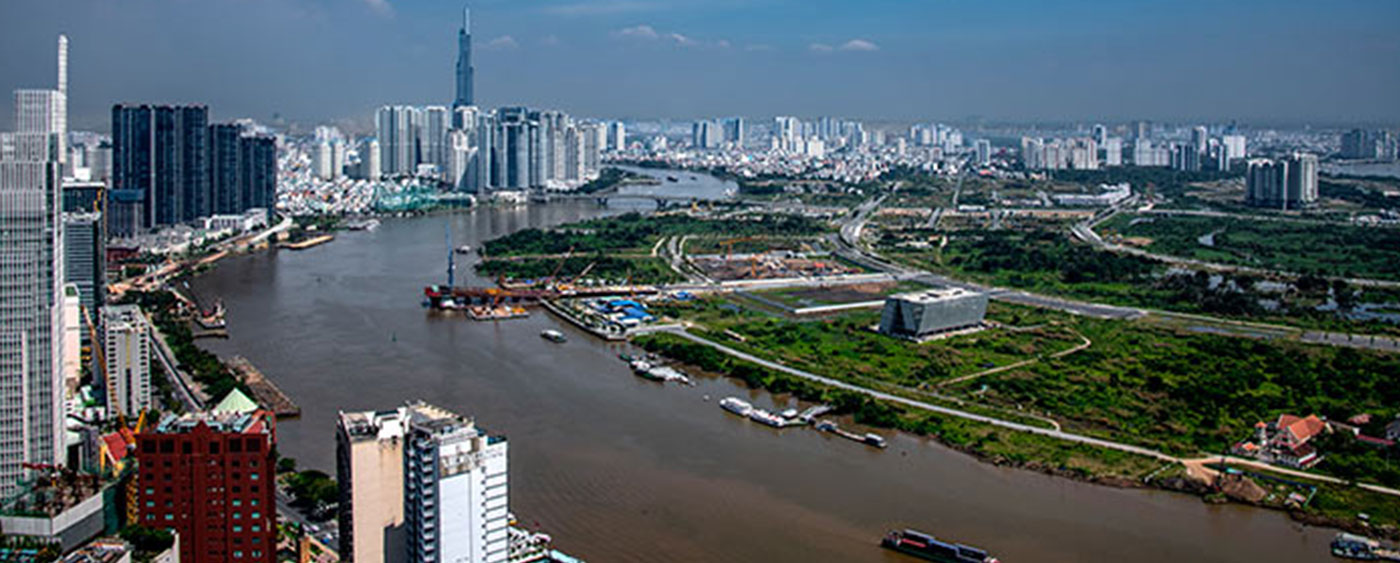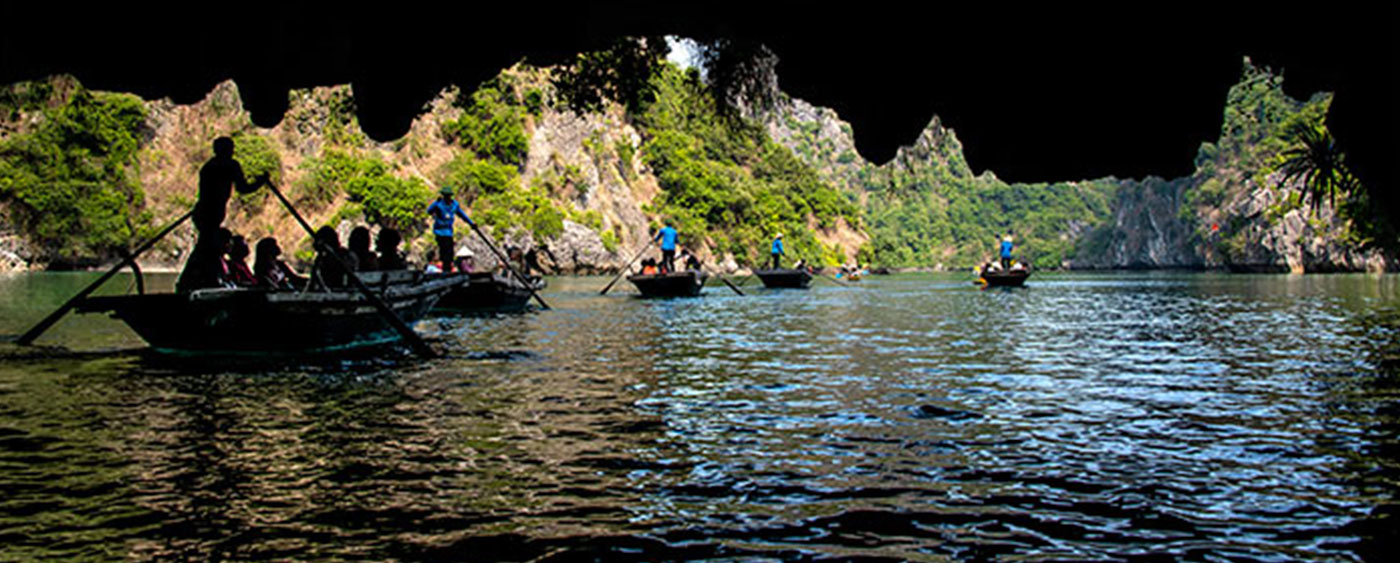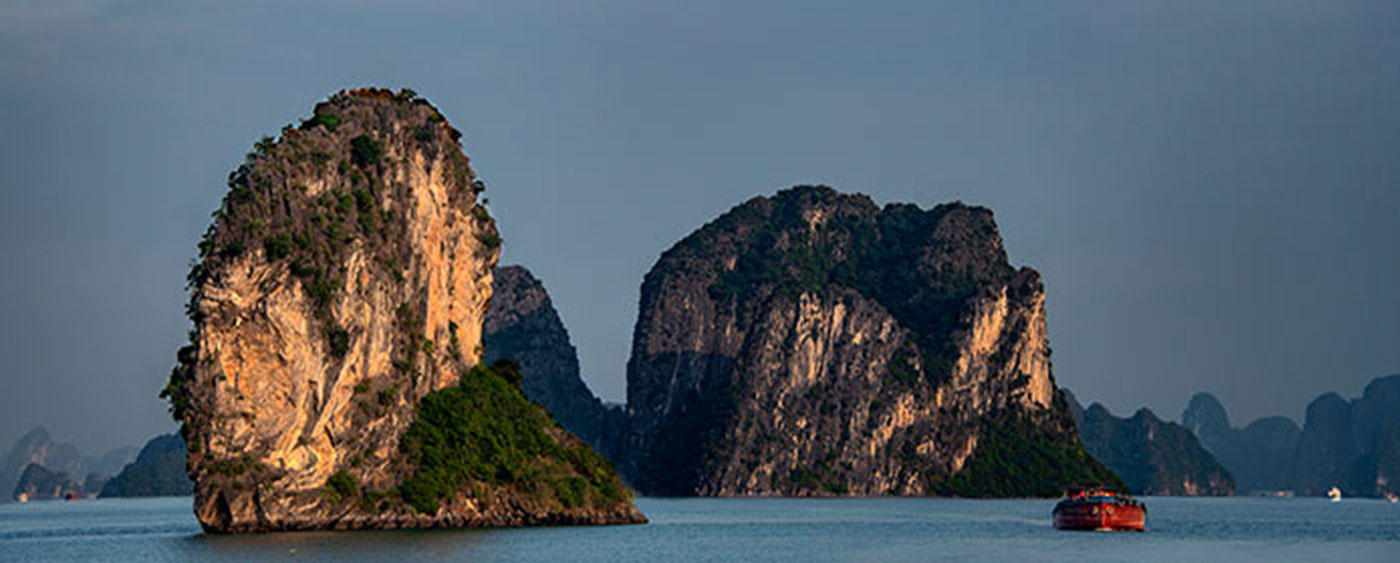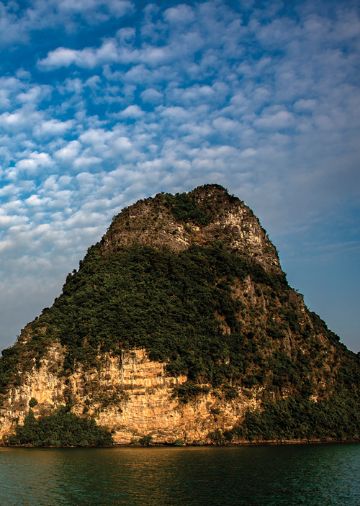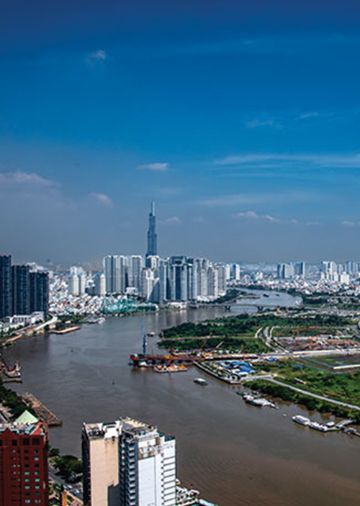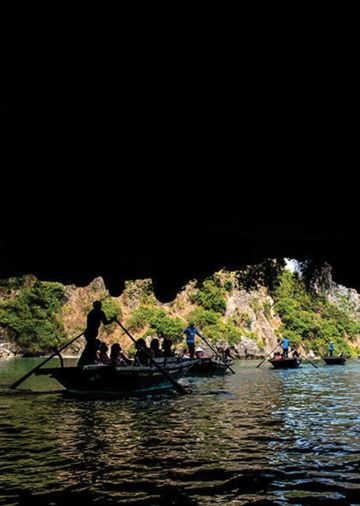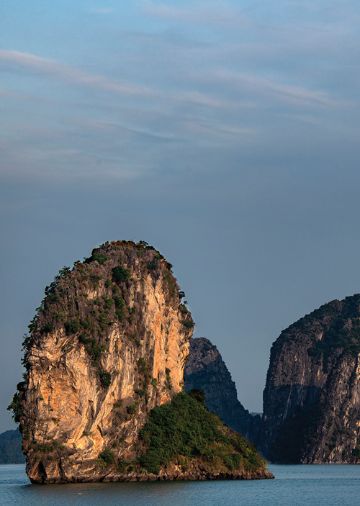
Vietnam Tales
- Travel & Wellness
- |
- 25 February 2020
- Kishan S Rana
Kishan S Rana puts this charming Asian nation in a sweeping historical context as he visits the vibrant city of Hanoi, wanders through its French Quarter, and explores the rock islands of Halong Bay.
 Day scene of Halong Bay, with its rocky islands that emerge straight out of the sea. Photograph © Ajit Rana
Day scene of Halong Bay, with its rocky islands that emerge straight out of the sea. Photograph © Ajit Rana
Imagine a scene in 1975: a relatively small country of perhaps 40 million; Vietnam (then divided into North and South), engaged in a virually non-stop ‘liberation struggle’ since 1946, first with France till 1954 (it colonized Indo-China), and immediately after that, with the US – 21 long years of warfare. The last US troops left by helicopter, from the US Embassy roof.
Today, it is transformed. It is almost an ‘outpost’ of the US; it is the largest trading partner – plus the only country I have visited where the US dollar circulates in parallel with a ‘Vietnam Dong’ – taxi drivers and small shops cheerfully accept both currencies (later we saw the same in Cambodia). Save among the oldies, the French language is forgotten, but most speak American English. Yet national pride is visible everywhere; its liberation struggle has steeled its people, shaped them. This helps their Communist Party.
We easily forget history. I had to look up these facts: in 1959 the US had 1000 ‘advisers’ helping South Vietnam regime; by 1964 that balooned to 23,000. That year, when the ‘Gulf of Tonkin’ incident took place (a US warship clashed with a North Vietnam attack craft) the US Congress allowed the US President to formally deploy US troops to defend South Vietnam, sending in 184,000 troops. North Vietman, already involved, then openly entered South Vietnam, helped war supplies from the USSR and China – the latter even sent hundreds of troops to North Vietnam, for air defense. Even by 1966, Defense Secy McNamara openly doubted if victory was ever possible. But the war went on.
The U.S. conducted large-scale ‘strategic bombing’ against both North Vietnam and Laos, plus Cambodia. Remember the movie ‘The Killing Fields’? US-Vietnam peace negotiations began in 1968, and culminated in the Paris Peace Accord in 1973. The war ended in 1975.
War losses: For the US, 58,220 killed and 153,200 wounded. North Vietnam lost 1.1 million soldiers, plus 250,000 South Vietnamese soldiers. North and South Vietnam lost more than 2 million civilians. The story gets worse: Vietnam is the most heavily bombed country in history. More than 6.1 million tons of bombs were dropped, compared to a gross total of 2.1 million tons in World War II. U.S. planes dumped 20 million gallons of herbicides to defoliate Viet Cong hiding places. It decimated 5 million acres of forest and 500,000 acres of farmland. [This summary is culled from Wikipedia and other sources].
Apologies for this history lesson, but it provides context.
After 1975: Vietnam remained deeply supportive of the Soviet Union, but relations with China went into tailspin, old animosities resurfaced. [Chinese empires had occupied Vietnam for 1000 years, till Vietnam won its first war against them in 938 AD. There exist strong ethnic and language connections (though French colonists imposed a Romanized alphabet which broke linguistic connections with the South Chinese dialects.] In 1979 a major armed clash took place, with Chinese troops entering Vietnam. It simmered and flared till 1990; Vietnamese proudly claim they won that long war too.
After the collapse of the Soviet Union in 1989, Vietnam transformed its foreign policy, speeding up new economic and social ties with the US, plus the West, in effect embracing capitalism, while retaining its single party, authoritarian political system. That produces a unique ‘Mixed Economy’.
When I first went to China in August 1963, we used to say that the best time to write your definitive book on a country is after 4 to 6 weeks. By then you knew everything. Later, the longer you stay, deeper become your doubts and questions. After a year, you realize that you hardly knew anything.
So in humility, as a short-term visitor, let me offer some superficial impressions.
First: Hanoi’s vibrancy and dynamism are palpable. It is a city of 9 million, with over 5 million motorcycles and scooters. It seems that half of them are on the road at any given time, quite literally buzzing through the streets like clusters of hornets, zipping in and out of every nook and narrow street.
 An old lady sits outside one of the very narrow frontage buildings in the heart of Hanoi. Photograph © Ajit Rana
An old lady sits outside one of the very narrow frontage buildings in the heart of Hanoi. Photograph © Ajit Rana
We were installed in ‘Damsels Hotel’, in the heart of the Old Town, literally in a warren of alleys. You wondered how any bus or large SUV could pass through these mostly two-way streets, but they managed, somehow. In the city centre and main shopping areas, the pavements are choked with parked motorcycles, plus restaurants that spill onto the sidewalk with low stools, and other shops. Pedestrians must walk on the road, dodging traffic. No one shouts or honks; the mood is of relaxed tolerance. The odd truck or bus that blocks the riles no one . This surely connects with that cheerful Vietnamese personality and a ready smile.
Our son Ajit had found us a superb hotel, just 19 suite-sized rooms, and surely the most friendly staff we have encountered (plus delightful breakfasts too; they don’t do meals, but many restaurants are in close vicinity). October is the start of the heavy tourist season, when the Mumbai like climate begins to moderate and cool down. The alleys are thronged with tourists, and there are hotels on every corner. Within 70 meters on each side of ours, we counted 7 of them. In 2018, Vietnam got 15.5 million foreign tourists, up 20% in one year.
 A Buddhist temple. Photograph © Ajit Rana
A Buddhist temple. Photograph © Ajit Rana
Second: everyone has their favourite excursion out of Hanoi and the choice is wide, thanks to many rivers and lakes, the luxuriant vegetation, and small towns nested in the mountains. We went to Halong Bay, almost 200 km south of Hanoi. It is connected by a fine autoroute. Leaving one’s hotel at 7:30 in the morning, and getting back around 8 PM. That gave time for a six-hour boat ride on the bay. Each boat, carrying 30 to 50 and more passengers, weaving in and out among the rock islands, outcrops that emerge from the sea, a few small, like strange creatures with fanciful names, and many more massive in size, all uninhabited. Some boats offer overnight accommodation.
 Night scene at Halong Bay. Photograph © Ajit Rana
Night scene at Halong Bay. Photograph © Ajit Rana
Third: we opted for a five-hour sightseeing tour of Hanoi, which was fascinating, covering inter alia the French Quarter, with the Assembly building, the Ho Chi Min Mausoleum, the Presidential Palace, the Foreign Ministry, and the military headquarters and garrison are located, including an Army Hotel, open to all. The city is studded with lakes and parks. That day was International Women’s Day, so many clusters of women in elegant traditional attire were to be seen – Mimi was welcomed to some of the photo shoots. We saw the original French prison where Vietnamese liberation fighters were imprisoned; in turn it housed American POWs who named it the ‘Hanoi Hilton’. Without any obvious irony, there is now also an authentic Hanoi Hilton. And the famous Hotel Metropole, the setting for many novels, remains a top property. Some of skyscrapers have been built or are under construction, but the hallmark houses of Hanoi are narrow, a street frontage of 20 or 12 or even10 feet, or less, but running to considerable depth, and a height of 5 to 10 floors – all a result of family sub-division of properties.
We travelled in a 1975-vintage open American jeep, with its original manufacture-plated fixed to the dashboard, with a driver and a loquacious, cheerful guide. He did not hesitate to speak on any subject, including political. He told us that the internet is accessible and one can surf any website, but all this is under tight scrutiny. Those that explore politically sensitive issues, receive warnings, followed by action if they do not pay heed. The print media is entirely state-controlled as are the TV channels, but people can watch foreign channels from anywhere in the world.
 Pic of train: A main railway line that passes through a busy residential and café area of Hanoi, with around 12 or 14 trains that pass close to the cafes. Photograph © Ajit Rana
Pic of train: A main railway line that passes through a busy residential and café area of Hanoi, with around 12 or 14 trains that pass close to the cafes. Photograph © Ajit Rana
Fourth, and final impressions: I spent a day at the Vietnam Diplomatic Academy, delivering 3 lectures (they offer BA level courses; intake 500 students each year, and run Masters courses as well); also spent almost two hours with several researchers at a closed-door discussion; we were treated to a nice lunch in a restaurant. Very keen students, but they did not seem too alert on international affairs, much less on issues like public diplomacy. The English language seemed a hurdle for many.
The country’s official system seemingly retains its old austere style, e.g. no staff cars at the Academy. Prices in restaurants are fairly low; a 7 km taxi ride cost US$ 4. Cars are imported, and charged 200% customs duty; luxury cars pay 300% duty. Streets are clean; even on the autoroute manual cleaners were at work. Shopkeepers were invariably friendly, even if one did not buy or bargained hard, say at the Night Market.
On our final day, I went in the evening to the lakeside plaza, for street photography. A group of high school students around 15 years in age, two girls and three boys, accosted me, asking very nicely if they could practice English; I agreed readily. We exchanged some polite words in simple language. When I explained my teaching work, they did not understand ‘diplomacy’. ‘International affairs’ and ‘foreign relations’ also did not work, though they searched vigorously on their smartphones. We then gave up.
 A woman lights incense sticks inside the temple. Photograph © Ajit Rana
A woman lights incense sticks inside the temple. Photograph © Ajit Rana
Minutes later a boy, seemingly 10 or 11 asked if I would practice English with him. He then stumped me: ‘You look like an Indian, am I right? India is a large country, with 1.3 billion people. It is a poor country, but rich in history and the talent of its people. It also gets very hot in the summer.’ I was stuck by his fluency and facts. We chatted awhile. Looking around, I saw an elderly chap, standing some 10 feet away, looking at us now and then; perhaps he was the boy’s grandpa. We continued our conversation for some minutes, and I then took leave; I had to get back to the hotel, and wished him success. Clearly foreign tourists are fair prey for keen language students.
Just a final note: While Hanoi is the capital of Vietnam, Ho Chi Minh City, which used to be Saigon in the old days, is a more ‘happening city’, filled with elegant buildings and a much more vivacious lifestyle than Hanoi. Hanoi as an old town, retains the flavour of a traditional city with some modernization along the periphery. While Ho Chi Minh, is largely now a bustling skyscraper town.
 Ho Chi Minh City skyline with the Saigon River. Photograph © Ajit Rana
Ho Chi Minh City skyline with the Saigon River. Photograph © Ajit Rana
Overall view: In current dollars, its per capita income in 2018 was US$2560, just over US$6000 in PPP terms (the World Bank puts India at $2050 and $7000). But Vietnam’s growth trajectory and economic prospects look brighter. Perhaps that is just an impression.
What both share as countries is a hard challenge from China. It is fascinating to compare how each handles its complexities with Beijing – Hanoi’s dispute in the South China Seas, over oil exploration, is even more acute than India’s confrontation across the Himalayas. Japan and South Korea are two other countries from whom we have much to learn, on that front.
A single political entity, the Vietnam Communist Party, dominates, but some ways criticism is tolerated. One reads in the international media of conferences in Hanoi where people criticise the party and the government, but in guarded language. Different Vietnamese, tour guides and others, referred to party leaders as ‘kings’, living in luxury behind high walls. As in China, there are rich businessmen, even billionaires, no doubt connected with those in power. State companies remain a strong force, but are clearly not allowed to monopolize business. The result is a thriving, high-employment economy. And Vietnam is a strong protagonist of free trade, and regional FTAs, another startling contrast to India. It connects well with ASEAN, Japan and others.
Vietnam appears as a special blend of Communist authority and a flexible economy and society, now in full boom. It has especially benefited from China reaching middle-income status, i.e. vacating manufacture of low-cost textiles and other consumer products – it has been the biggest gainer, followed by Bangladesh. India? We tie our own hands with legacy regulations that date to the 1960s, (e.g. small industry reservations, labour laws). That’s another story.
 Inside a Buddhist temple. Photograph © Ajit Rana
Inside a Buddhist temple. Photograph © Ajit Rana
FOLLOW US ON INSTAGRAM

Lifestyle Insider is a kind of junction point, connecting people with diverse interests that touch on the more luxurious aspects of lifestyle – fashion, design, travel, food and spirits, art, watches and jewellery, cars, yachts, and aviation, and technology. People today don’t fit into boxes and categories. In our individual ways, we are interested in diverse themes, products, and the challenges that face our world today. You will judge how well this effort of mine caters to your passions and proclivities.
Lifestyle Insider is a showcase of all that is beautiful and luxe. Behind every creation, is a designer, chef, entrepreneur, or a design maison. I have delved into my own appreciation for objetsde luxe that I have admired over the years – be it a love of fashion from the world’s top Parisian and Italian fashion maisons and their ’90s muses, or the care that goes into sari and Indian textile collections in my own family. Growing up on four continents, as the daughter of a former Indian Ambassador, I’ve seen a remarkable array of historic places and met a myriad people. My aim is to bring my world view into this website, a curation of what I find particularly stunning, unique, and newsworthy.
It’s an exciting time for brands all over the world. With change comes opportunity. With the global ‘reset’ and uncertainty on many fronts, there is a chance to write a new script. Let’s be those pioneers.
A bit about me:
A luxury and fashion journalist with 25 years of experience in publishing and magazine journalism, I have edited some of India’s top fashion and luxury magazines. I got my BA in Comparative Literature from UC Berkeley, and went on to receive my Master’s in English and French from the University of Strasbourg, France. I have also studied German and Film. I live in Gurugram, India, and look forward to once again exploring our world with a new-found freedom.
Priya Kumari Rana
Founder and EditorContact Us
Mail us @ lifestyleinsiderindia@gmail.com
